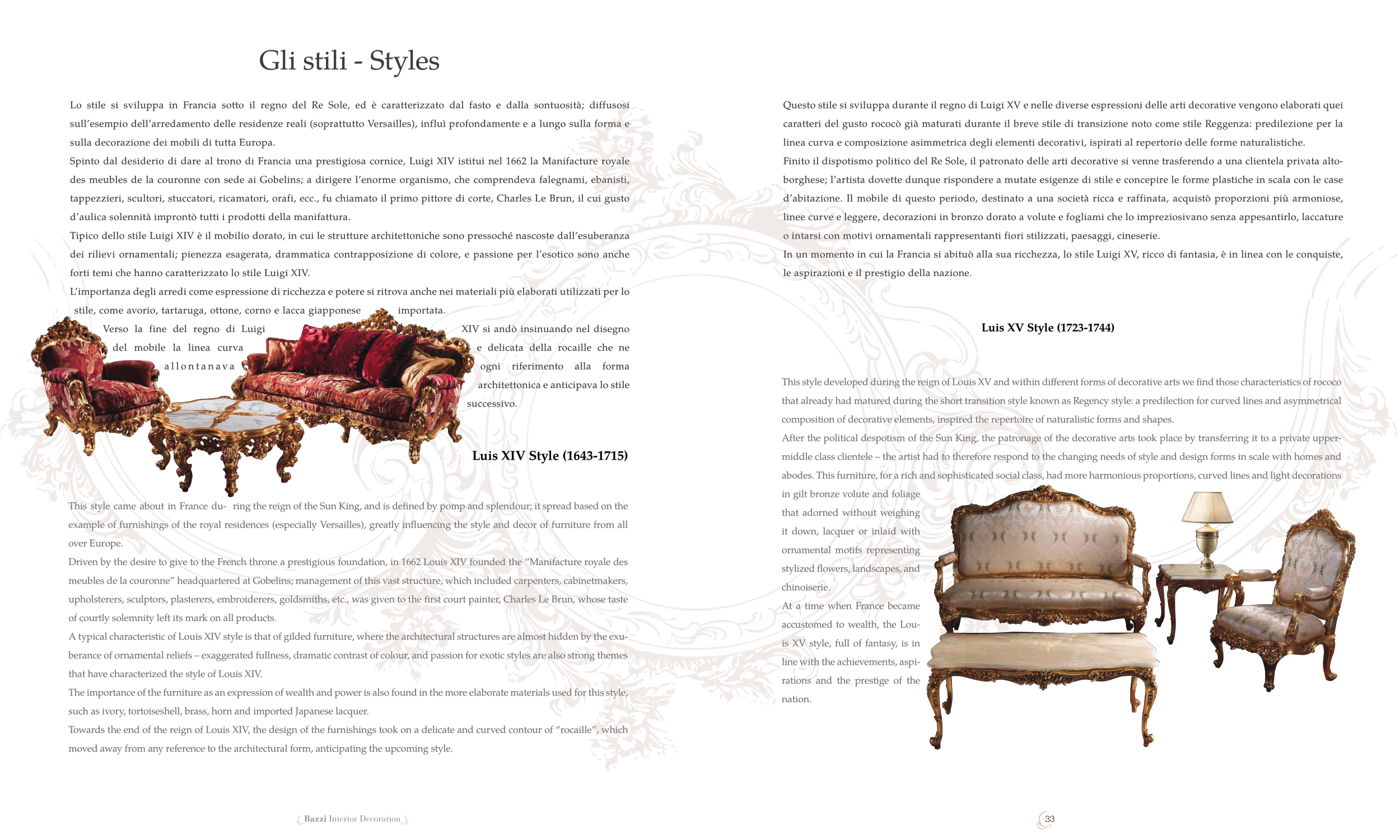Luis XIV Style (1643-1715)
Lo stile si sviluppa in Francia sotto il regno del Re Sole, ed è caratterizzato dal fasto e dalla sontuosità; diffusosi
sull’esempio dell’arredamento delle residenze reali (soprattutto Versailles), influì profondamente e a lungo sulla forma e
sulla decorazione dei mobili di tutta Europa.
Spinto dal desiderio di dare al trono di Francia una prestigiosa cornice, Luigi XIV istituì nel 1662 la Manifacture royale
des meubles de la couronne con sede ai Gobelins; a dirigere l’enorme organismo, che comprendeva falegnami, ebanisti,
tappezzieri, scultori, stuccatori, ricamatori, orafi, ecc., fu chiamato il primo pittore di corte, Charles Le Brun, il cui gusto
d’aulica solennità improntò tutti i prodotti della manifattura.
Tipico dello stile Luigi XIV è il mobilio dorato, in cui le strutture architettoniche sono pressoché nascoste dall’esuberanza
dei rilievi ornamentali; pienezza esagerata, drammatica contrapposizione di colore, e passione per l’esotico sono anche
forti temi che hanno caratterizzato lo stile Luigi XIV.
L’importanza degli arredi come espressione di ricchezza e potere si ritrova anche nei materiali più elaborati utilizzati per lo
stile, come avorio, tartaruga, ottone, corno e lacca giapponese
importata.
Verso la fine del regno di Luigi
XIV si andò insinuando nel disegno
del mobile la linea curva
e delicata della rocaille che ne
a l l o n t a n a v a
ogni
riferimento
alla
forma
architettonica e anticipava lo stile
successivo.
This style came about in France du- ring the reign of the Sun King, and is defined by pomp and splendour; it spread based on the
example of furnishings of the royal residences (especially Versailles), greatly influencing the style and decor of furniture from all
over Europe.
Driven by the desire to give to the French throne a prestigious foundation, in 1662 Louis XIV founded the “Manifacture royale des
meubles de la couronne” headquartered at Gobelins; management of this vast structure, which included carpenters, cabinetmakers,
upholsterers, sculptors, plasterers, embroiderers, goldsmiths, etc., was given to the first court painter, Charles Le Brun, whose taste
of courtly solemnity left its mark on all products.
A typical characteristic of Louis XIV style is that of gilded furniture, where the architectural structures are almost hidden by the exu-
berance of ornamental reliefs – exaggerated fullness, dramatic contrast of colour, and passion for exotic styles are also strong themes
that have characterized the style of Louis XIV.
The importance of the furniture as an expression of wealth and power is also found in the more elaborate materials used for this style,
such as ivory, tortoiseshell, brass, horn and imported Japanese lacquer.
Towards the end of the reign of Louis XIV, the design of the furnishings took on a delicate and curved contour of “rocaille”, which
moved away from any reference to the architectural form, anticipating the upcoming style.
Gli stili - Styles
Questo stile si sviluppa durante il regno di Luigi XV e nelle diverse espressioni delle arti decorative vengono elaborati quei
caratteri del gusto rococò già maturati durante il breve stile di transizione noto come stile Reggenza: predilezione per la
linea curva e composizione asimmetrica degli elementi decorativi, ispirati al repertorio delle forme naturalistiche.
Finito il dispotismo politico del Re Sole, il patronato delle arti decorative si venne trasferendo a una clientela privata alto-
borghese; l’artista dovette dunque rispondere a mutate esigenze di stile e concepire le forme plastiche in scala con le case
d’abitazione. Il mobile di questo periodo, destinato a una società ricca e raffinata, acquistò proporzioni più armoniose,
linee curve e leggere, decorazioni in bronzo dorato a volute e fogliami che lo impreziosivano senza appesantirlo, laccature
o intarsi con motivi ornamentali rappresentanti fiori stilizzati, paesaggi, cineserie.
In un momento in cui la Francia si abituò alla sua ricchezza, lo stile Luigi XV, ricco di fantasia, è in linea con le conquiste,
le aspirazioni e il prestigio della nazione.
This style developed during the reign of Louis XV and within different forms of decorative arts we find those characteristics of rococo
that already had matured during the short transition style known as Regency style: a predilection for curved lines and asymmetrical
composition of decorative elements, inspired the repertoire of naturalistic forms and shapes.
After the political despotism of the Sun King, the patronage of the decorative arts took place by transferring it to a private upper-
middle class clientele – the artist had to therefore respond to the changing needs of style and design forms in scale with homes and
abodes. This furniture, for a rich and sophisticated social class, had more harmonious proportions, curved lines and light decorations
in gilt bronze volute and foliage
that adorned without weighing
it down, lacquer or inlaid with
ornamental motifs representing
stylized flowers, landscapes, and
chinoiserie.
At a time when France became
accustomed to wealth, the Lou-
is XV style, full of fantasy, is in
line with the achievements, aspi-
rations and the prestige of the
nation.
Luis XV Style (1723-1744)
33
Bazzi Interior Decoration


